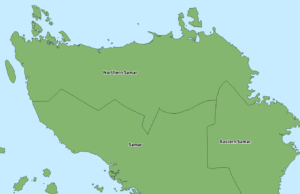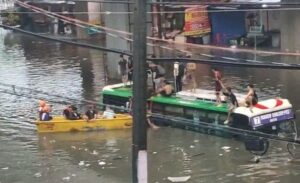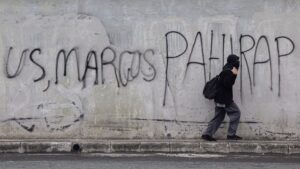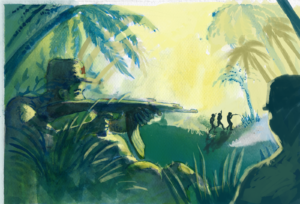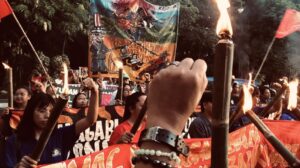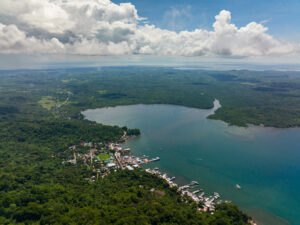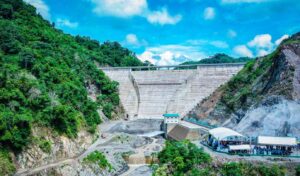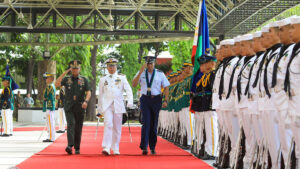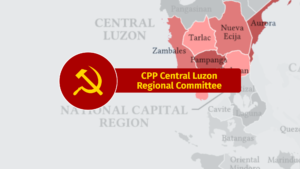Boldly intensify guerrilla warfare and wage all-out resistance against the US-Duterte fascist regime! Carry forward the people’s war to greater heights!
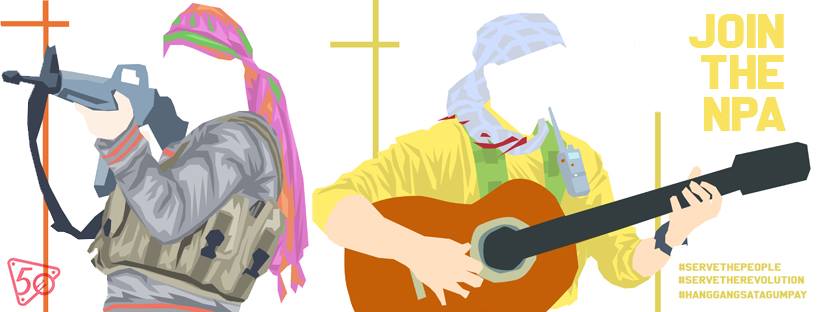
Message of the Central Committee of the Communist Party of the Philippines on the occasion of the NPA’s 50th founding anniversary
The Central Committee of the Communist Party of the Philippines, together with the Filipino people and all their revolutionary forces, salutes and extends most militant greetings to all the valiant Red commanders and fighters on the occasion of the 50th founding anniversary of the New People’s Army (NPA).
Let us celebrate the victories accumulated through five decades of waging people’s war, as well as those achieved in the past year of waging armed resistance against the ruthless attacks of the US-Duterte fascist regime.
Let us honor all the heroes and martyrs of the people’s war who gave their lives for the revolutionary cause. Let us recognize as well the contributions of all veterans who served the NPA and who now continue to serve the revolution in other forms. The achievements of the past 50 years could not have been accomplished without their sacrifices. Their names will forever be etched in the annals of the Filipino people’s epic resistance. Their examples inspire us to carry forward the difficult tasks ahead.
Let us also firmly salute the thousands of Red commanders and Red fighters of the NPA, both the old-timers and new recruits. They are driven by the desire to defend the people and advance their aspirations. They are ever determined to wage armed struggle. They are models of courage and selflessness.
The worsening crisis of the semicolonial and semifeudal ruling system underscores the need for waging a national democratic revolution. This is made more starkly clear by the Duterte regime’s abuse of power, corruption, widespread violations of human rights, mass murder, war crimes, subservience to US imperialism, excessive foreign borrowing, onerous taxes and sellout of the country’s wealth and patrimony.
Duterte is the face of the rottenness of the entire ruling system. His anti-people anti-national and anti-democratic policies are causing the people grave social and economic hardships. He has unleashed brutal wars accompanied by widespread abuses and fascist violence. In his lust for more power, he is set on establishing a fascist dictatorship in order to perpetuate dynastic rule and secure the entire system through barefaced force.
The broad masses of the Filipino people are suffering from worsening crisis conditions and have no other recourse but to wage revolutionary mass resistance and armed struggle to put an end to their grievous situation. The crisis of the ruling system generates ever favorable circumstances for the accelerated growth of the revolutionary forces. Duterte’s tyranny and reign of terror is pushing more and more people to support and join the NPA.
The NPA is gathering nationwide momentum for a major advance of the people’s war in the coming years. It is mounting tactical offensives, seizing weapons, and recruiting and training new Red fighters. The NPA is overcoming the all-out offensives of the reactionary armed forces under Duterte’s declared aim of putting an end to the armed resistance. Under the Party’s leadership, the NPA is set on accomplishing ever bigger victories in the coming years.
A further sharp economic downturn threatens to rock the entire ruling system in the Philippines as the global capitalist system continues to suffer from prolonged depression and is now in the process of plunging into another financial crisis of unprecedented proportions. Monopoly capitalism is unleashing the worst forms of and exploitation against the toiling masses around the world. Imperialist rivalries over control of spheres of trade and investments are heightening.
By winning more and more victories, the NPA is helping inspire the oppressed and exploited peoples across the world to take up arms and wage revolutionary resistance against imperialism and all reaction.
Continuing world capitalist crisis and deepening contradictions
THE CURRENT WORLD situation is characterized by unresolved capitalist depression leading to ever worsening conditions of oppression and exploitation; as well as by growing inter-imperialist contradictions between the big powers where US imperialism insists on asserting unipolar power causing tensions and risking antagonism within the prevailing multipolar institutions.
Billions of workers and peasants across the world are suffering increasing intolerable conditions. They are fighting back and are ever ready to respond to the call to wage revolutionary resistance under the banner of genuine communist parties.
Amid persistent conditions of stagnation, imperialist agencies themselves are raising fears of an impending economic storm. They have warned of the international financial system collapsing under the weight of global debt. Capitalist overproduction is heightening contradictions between big imperialist powers over trade and economic arrangements.
Economic stagnation continues to engulf the US and Europe. The US economy continues to slide from its status as the world’s biggest economy, as leading US corporation report falling profits. Surveys show investments slowed down by 1.2% last year. The US is now burdened by a $22 trillion debt.
Germany recently reported contraction in industrial production, with car manufacturers suffering from slow demand and planning to cut their workforces. Italy is in recession. The British economy is suffering from production disruptions as it faces uncertainties over the absence of clear trade and economic arrangements for stable sources of capital goods and raw materials when it formally leaves the European Union.
The capitalist world is trembling over the prospect of a slowdown of the Chinese economy, which officially registered a 6.6% growth last year, its slowest in close to 30 years. Despite tax cuts and other state financial stimulus measures, Chinese manufacturing activity contracted in 2018 amid rising inventories of unsold commodities, highlighted by last year’s car sales decline, the first in over two decades. It is also under pressure in the face of escalating trade disputes with the US where nearly 20% of its exports go. The Chinese stock market plummeted by 27% at the end of 2018. Chinese demand for imports are slowing down, causing a deep impact on countries such as the Philippines engaged primarily in semimanufacturing production of goods for export.
Desperate to overcome economic stagnation, the US is shaking up existing trade and investment liberalization agreements. It has imposed tariffs on Chinese imports to press China to import more soya beans and other commodities from the US to cut into China’s trade surplus which rose to a record $323.3 billion last year, as well as to press China to further liberalize foreign investment laws and remove technology transfer requirements and state subsidies. Three months of trade negotiations between the US and China since December have yet to result in an agreement.
The US government also recently declared that US auto imports are a “national security threat” as it announced plans to impose 25% duties on cars imported from Europe, especially from Germany, in a bid to protect US car manufacturers. Trade and investment policy disputes are also at the heart of the failure of the United Kingdom to come up with a Brexit deal.
On January, Trump declared a national emergency and arrogated the power to allot $5.6 billion for building the US-Mexico border wall purportedly to prevent the illegal entry of immigrants into the US, a measure rejected by the US congress. In reaction to the rise of fascism and ultraright policies of the Trump government, liberals have become more vocal with some Democrats in the US congress threatening to start impeachment proceedings against Trump.
Economic stagnation in the US is pushing it to assert ultranationalism and hegemonic power more vigorously, heightening contradictions with rival powers. It is giving rise to fascist and ultrareactionary policies. Unilateral actions by the US have been described as an onslaught against multilateralism. Its open support for a failed power-grab last January in Venezuela was opposed by Russia and China which continue to recognize the Maduro government. The US has also failed to fully impose economic sanctions against Iran. Rival powers are also critical of US moves to undermine the integrity of the European Union, as well as its push to appoint a pro-tariffs American official to head the World Bank.
Last February, the US withdrew from the Intermediate Range Nuclear-Force (INF) Treaty which it forged with Russia in 1987 to limit the capabilities of nuclear weapons. The treaty is set to expire after six months (in July). The US has long sought to withdraw from the treaty in order to accelerate the development of new nuclear weapons as it engages its rivals in an intensified arms race in its bid to retain global military supremacy.
Other imperialist powers are racing to increase their own military capacity. China has announced plans to increase spending to further strengthen its military including building nuclear aircraft carriers to surpass US strength in the Pacific. Japan also recently announced plans to increase spending on military purchases from the US to new record levels over the next five years. European defense ministers have established the Europe Defense Fund, the Permanent Structured Cooperation and the European Intervention Initiative with the aim of reducing dependence on the US. France and Germany have jointly endorsed the concept of building a “European Army.”
Big power rivalries increase the threat of war and nuclear holocaust and incite ultranationalism, fascism and racism. But weak and small countries could take advantage of the inter-imperialist contradictions to defend their sovereign rights and interests. Despite US pressure in negotiations, North Korea continues to assert its right to develop nuclear weapons even as it declared willingness to end its nuclear program if the US will lift sanctions. Cuba remains a bulwark of anti-US imperialism. Venezuela has withstood US sanctions with aid coming from Russia and China. Iran continues to carry out trade with Germany, France, China, Russia and others despite US sanctions.
Across the world, people are waging resistance in different fronts against worsening social and economic measures under the neoliberal policy regime, as well as against imperialist intervention and military aggression. In Venezuela, millions of people have rallied behind the Maduro government against US intervention. Tens of thousands of people in France brave increasingly violent police suppression and have mounted weekly demonstrations since October against new taxes and social spending cuts and demanding the ouster of the government. Similar protests are spreading across Europe. Conditions are ever favorable for communist forces to provide proletarian class leadership to the broad toiling masses.
Armed struggles continue to persist. The Kurdish people continue to assert their right to self-determination through armed struggle. The people’s war in India and the Philippines persevere and continue to accumulate victories.
Duterte intensifies fascist rampage amid deteriorating socio-economic conditions
THE FILIPINO PEOPLE continue to suffer from deteriorating socio-economic conditions marked by rising prices, measly incomes, widespread joblessness, rural displacement and lack of basic social services. The US-Duterte regime rampages on with its war of suppression and scheme to establish a fascist dictatorship.
Recent indicators confirm that the import-dependent and export-oriented Philippine economy remains in an acute state of crisis. The country’s trade deficit last year ended at a record high of P41.44 billion, which is 51.3% higher than the previous year as a result of global economic stagnation and weak demand for Philippine semimanufacture exports. Government deficit hit P558.3 billion last year. To bridge the fiscal gap, the Duterte government borrowed $1.5 billion from foreign creditors last January.
Foreign direct investments dropped by more than 3% in the first 11 months of 2018, with new approvals in economic zones dropping by 41% in 2018. This is highlighted by the January filing of bankruptcy of shipbuilding company Hanjin, which employs around 30,000 workers.
Joblessness is at historic highs under Duterte. Reports last January show that the number of Filipinos with jobs dropped by 387,000 compared to the same time last year. To mask the severity of the jobs crisis, Duterte’s statisticians have simply stopped counting millions of jobless as unemployed by cutting the labor force participation rate to 60.9%, a 30-year low, thereby deceptively bringing down the unemployment rate to 5.2%.
The real unemployment rate, which includes those dropped from the labor force count, is estimated at 9.8% and can even go higher if one considers the number of underemployed who are, in fact, unemployed. A recent study show that the average number of new jobs created annually under Duterte has dropped to 81,000, less than ten percent compared to the annual average 825,000 during the previous decade. Duterte’s promise of job creation with his infrastructure program remains unfulfilled.
As a result primarily of recent tax impositions, annual inflation rate for 2018 rose to 5.2%, up from 2.9% the previous year and 1.3% in 2016. Reports that January and February inflation dropped to 4.4% and 3.8% provide little relief as prices of food and other basic commodities continue to rise while wages remain grossly low. Prices of fuel products have increased by at least seven times over the past few weeks. By end of 2018, the daily cost of living in the National Capital Region (NCR) is at P1,196 for a family of six and P996 for a family of five. Daily NCR worker’s wages rose insignificantly by P25 to P537 which is around half of the daily living cost.
Rice import liberalization, which the Duterte regime deceptively describes as “tariffication,” took effect on March 5. The expected deluge of rice imports will cause grave negative impact on millions of local rice farmers, mostly tenants and farm workers, who are set to suffer loss of income in the face of lower domestic buying rates amid rising costs of production and high land rent. Duterte’s officials are encouraging farmers to abandon rice production, in the hope of that vast tracts will be made available to land-use conversion.
Infrastructure, tourism and energy projects, as well as the expansion of mining and plantation operations are causing widespread rural displacement. Up to 1.7 million jobs in the agricultural sector were lost last year. To placate rising rural restiveness, Duterte has mounted public stunts of fake land reform to misrepresent the handing out of land transfer certificates requiring peasants to pay regular amortization as “land distribution.”
Cases of human rights abuses have spiked as the Duterte regime’s military and police forces go on a rampage in an intensification of its war of suppression and fascist terror. There is a conspicuous rise in the number of military and police attacks against civilians and legal organizations in Negros, Samar and Bicol, which were put under state of emergency and de facto martial law since November last year. Military abuses also continue unabated in Mindanao and across the country.
Extrajudicial killings of peasant leaders and activists are rampant. The military and police persist in indiscriminately accusing and labeling civilian residents and whole communities of being members or supporters of the NPA and rounding them up as “surrenderees.” Children’s rights are wantonly violated by the military with recent reports of arbitrary detention of minors. Military operations supported by aerial and artillery shelling continue to cause widespread trauma among the local population. Entire communities in Surigao del Sur, Samar, Bukidnon, Negros Oriental and elsewhere have been forced to evacuate in the face of occupation by fascist troops of their villages.
Military and police operations have been most vicious in Negros under the so-called synchronized enhanced managing of police operations (SEMPO or Oplan Sauron) where they conduct simultaneous pre-dawn and dawn raids and saturation drives covering up to scores of barrios in several municipalities. Patterned after the “Oplan Tokhang” campaign of mass killing, these are carried out on the pretext of serving warrants of arrest for common crimes and rebellion but end up in targeted liquidation of peasant leaders, multiple arbitrary killings and arrests. Droves of armed soldiers swarm and terrorize entire communities.
Duterte now heads what is virtually a civil-military junta in the form of the so-called National Task Force to “end local communist armed conflict.” Invoking the so-called “whole of nation approach” (a rehash of the previous “whole-of-government” policy) under the National Internal Security Program, various government agencies and local government officials are reduced to serving as adjuncts of the AFP in its counterinsurgency drive.
The military and police use blanket Red-tagging and terrorist-labeling to target political and social activists. The regime has targeted progressive party-list groups, and sectoral organizations of workers, peasants, urban poor, national minorities, teachers, journalists, lawyers, church people, youth and other sectors. Their members have been subjected to surveillance, harassment, vilification and extrajudicial killings. State agents have circulated fliers and posters listing their names as “communists.” For several weeks early this year, alternative media outlets were subjected to relentless cyber attacks in an attempt to silence them by making their websites inaccessible. Similar attacks were carried out for weeks against the Party’s website.
The ruling classes of big business oligarchs and bureaucrat capitalists are mired in deep factional struggles. Rival political and economic cliques are furiously competing for franchises and kickbacks and cuts in overpriced government infrastructure projects and contracts. Conflicts over pork barrel allocation which have resulted in the non-signing of the 2019 budget indicate an intense power play between Duterte and other cliques, including the Arroyos with whom he is in an electoral and political alliance.
These ruling class rivalries combine with the people’s discontent over deteriorating socio-economic conditions to cause a deep crisis in the ruling political system. This is made even worse by Duterte’s bent to monopolize power and perpetuate his family’s bureaucrat capitalist rule resulting in heightening antagonisms.
All indicators show Duterte wants to establish himself a fascist dictator either by railroading charter change in congress to establish a “federal” system of government under which he centralizes power and appoints allied warlords and political dynasties as regional and local leaders; or by outrightly declaring emergency rule and claiming autocratic powers.
He is using nationwide de facto martial law powers, as well as his fake drug war, to ensure the outcome of the midterm elections in May, or to scuttle it altogether. Duterte is setting up the scenario for widespread fraud. He is using threats of inclusion in his made-up “narcolist” against his rivals, as well as Red-tagging, threats and harassment against progressive, patriotic and democratic party-list organizations to prevent them from gaining more seats in parliament.
Armed struggle advances nationwide as people resist Duterte’s fascist regime
THE REVOLUTIONARY ARMED struggle being waged by the New People’s Army continues to advance nationwide. In 2018, the NPA surmounted the enemy’s all-out offensives and focused military operations. Units of the NPA encountered initial difficulties with the enemy’s siege tactics up to the first half of 2018, especially in Mindanao, but would soon get their offensive bearings by the second half.
Last year, the NPA mounted several hundred tactical offensives across the country. Widespread sniping actions have been carried out to harass and punish abusive enemy units and personnel, More importantly, NPA units have mounted significant annihilative actions where entire enemy units were wiped out and their weapons seized by the Red fighters. The NPA was able to seize at least 107 high powered rifles from the enemy armed forces and police, private armies and security agencies serving big mining operations. The biggest hauls of high powered firearms were carried out in Kalinga (30), Agusan del Sur (28) and Northern Samar (10).
Since 2015, the AFP has declared its immediate aim of crushing the NPA in eastern Mindanao. At the outset of 2018, the AFP deployed as much as 75% of its combat troops in the island to suppress both the NPA and the Moro armed resistance and mount one focused military operation after another, employing battalions of ground troops supported by artillery and helicopter gunships. This gave the revolutionary forces in Luzon and Visayas the opportunity to expand and step up their work. With the steady growth of the NPA in Luzon and Visayas regions, the AFP has been forced to reduce its troop deployment in Mindanao to 65% by the end of 2018 and further down to 60% recently.
In the face of all-out enemy offensives, NPA units in Mindanao were able to fight back valiantly. There are NPA units and guerrilla fronts which sustained losses as a result of exposure to the enemy’s intelligence operations during the 5-month simultaneous unilateral ceasefires in August 2016 to January 2017, failure to quickly adjust to the heightened offensives soon after the lifting of the ceasefire and also due to internal problems of self-constriction and overdispersal which made them vulnerable to enemy encirclement. Overall, however, the NPA has been able to overcome the enemy’s encirclement and gradual constriction campaigns by taking advantage of wide gaps between enemy units and mounting tactical offensives to counter-encircle isolated enemy units, as well as hit them from their rear and flanks. With the deep and extensive support of the masses and with mastery of guerrilla warfare, the NPA in Mindanao continued to steadily advance and expand its ranks.
The enemy suffered at least 600 casualties in 2018, with more than 380 killed in action, more than 40% higher than the previous year. Units of the AFP that suffered the most casualties were those deployed in focused military operations in north central and northeastern Mindanao provinces where NPA units were able to carry out active defense and frustrate the enemy’s offensives. The AFP would suffer defeat after defeat with at least 185 enemy troops killed in action across eastern Mindanao.
The Marine Landing Battalion Team 2 suffered the single biggest loss with 21 of its rampaging troops killed in an NPA ambush in Sultan Kudarat last September. In the same province, at least 35 AFP soldiers belonging to the 3rd Marine Company Reconnaissance Group were killed when the AFP’s own artillery bombs hit their position after being overrun by an NPA ambush last October.
In the face of the steady nationwide growth of the NPA, Duterte’s security officials have already toned down on their earlier braggadocio of defeating the NPA by middle of 2019. They have instead moved their “deadline” to the end of 2022.
While waging armed struggle, the NPA and the peasant masses continue to establish and strengthen mass organizations of peasants, women, children and cultural activists. These organizations build self-defense committees to help maintain peace and order and community defense. Units of the people’s militia are built and trained. All these serve as base for the formation of revolutionary committees at the village and higher levels which act as organs of political power and basic units of the people’s democratic government.
Supported by the NPA, peasant mass organizations continue to carry out land reform struggles in line with the Party’s Revolutionary Guide to Land Reform. Under its minimum program, thousands of poor peasants and farm workers in the guerrilla fronts have stood up over the past year to demand the lowering of land rent, higher wages and fair prices for their products. They also carry out elementary forms of cooperation and conduct production campaigns to raise income. The maximum program of land confiscation and distribution is carried out in revolutionary base areas where the gains can be defended by the NPA and the people’s government.
Under the auspices of the organs of political power, literacy and numeracy programs for children and adults, mass clinics and health campaigns, raising production, cultural work and other mass campaigns to address the well-being of the people are being carried out. Having preserved its strength and persevered through one of the biggest nationwide offensive campaigns of the AFP in the past years, the NPA is now in a position to carry forward the people’s war to even higher levels in the coming years.
Amid deteriorating socio-economic conditions and the fascist rampage of the US-Duterte regime, the justness and necessity to wage revolutionary armed struggle is exceedingly clear to the Filipino people.
At the same time, the masses of workers and peasants and the broad range of democratic sectors are resolutely carrying forward legal struggles to defend and assert their democratic rights. Legal progressive and national democratic forces are tenaciously waging resistance amid martial law conditions in Mindanao and de facto nationwide martial law under which they face threats of arrest, detention, torture and murder by state forces.
The united front against Duterte’s tyranny continues to expand, bringing together a broad range of forces. They are exposing and opposing Duterte’s plans for charter change as part of his scheme to establish an open fascist dictatorship. They are raising vigilance against Duterte’s plans to manipulate the outcome of the elections through force or rigging the electronic counting and canvassing system.
They demand justice for all victims of widespread abuses of human rights. They are seeking legal redress even in the reactionary courts, in the parliament and other fora. Most importantly, they continue to mount assemblies and demonstrations to exercise the people’s collective rights and manifest their opposition to Duterte’s reign of terror and clamor for the ouster of the fascist despot.
They are also voicing out their grievances against rising prices, onerous taxes, low wages, decrepit public utilities, lack of basic social services, excessive borrowing, overpriced government projects, widespread land-use conversion, land grabbing, environmentally destructive infrastructure projects, pork barrel funds, sell-out of the country’s resources and patrimony, US military presence, intervention and support for the fascist regime, and other problems that beset them.
As the Filipino people wage anti-imperialist, antifeudal and antifascist struggles under the Duterte regime, more and more are joining the revolutionary underground. Allied organizations of the National Democratic Front continue to expand in the countryside, in the cities and town centers, as well as overseas. They provide a wide base of support for the revolutionary armed struggle.
The Party continues to strengthen ideologically, politically and organizationally. It is firmly leading the people’s army and uniting the Filipino people to struggle to overthrow the US-Duterte fascist regime.
Amid worsening conditions of the semicolonial and semifeudal system, the broad masses must be roused to wage revolutionary armed struggle in unprecedented numbers. Duterte’s rotten, fascist, and puppet regime are driving the Filipino people to join the NPA as it carries forward the people’s war to even higher levels.
Boldly intensify guerrilla warfare! Wage all-out resistance against US-Duterte regime and carry forward the people’s war!
THE NPA WAS established in the second district of Tarlac fifty years ago with 60 Red fighters, nine automatic rifles and 26 inferior firearms. It had a mass base of 80,000. Today, the NPA has several thousand Red fighters armed with high powered rifles. It also has are a far bigger number of forces in units of the people’s militia and in self-defense corps that employ less powerful and traditional weapons and explosives. It operates in more than 120 guerrilla fronts covering more than 8,000 barrios in around 700 towns and cities of 70 provinces. It enjoys the support of hundreds of thousands of mass activists and mass base that reaches into several millions.
The victories achieved by the New People’s Army during the past fifty years are a testament to the correctness of the general line of people’s democratic revolution through protracted people’s war and leadership of the Communist Party. The Party continues to develop and enrich the strategy and tactics of people’s war in the Philippines by drawing lessons from its own rich experience, as well as from the experiences of other countries and by creatively applying the basic principles of Marxism-Leninism-Maoism on the concrete conditions and practice of Philippine revolution.
In the course of five decades of people’s war, we have built a nationwide people’s army that is politically conscious, disciplined and determined to wage people’s war. It carries out extensive and intensive guerrilla warfare based on an ever widening and deepening mass base. It has built organs of political power which set the foundations for building the people’s democratic government nationwide representing the interests of workers, peasants and other progressive and patriotic classes. Land reform is extensively being carried out to address the principal democratic demand of the Filipino people. These victories and many others surpass those during the previous three and a half centuries of resistance against colonialism and neocolonialism.
The NPA has frustrated all sorts of US-directed and -supported campaigns of encirclement and gradual constriction mounted by the AFP in the past fifty years. Like all previous oplans, Duterte’s Oplan Kapayapaan and its National Internal Security Program are bound to fail in its declared aim of crushing the NPA by 2022.
The Filipino people are carrying forward their anti-imperialist, antifeudal and antifascist struggles, expanding their united front and mounting resistance against the US-Duterte fascist regime.
Under the leadership of the Party, the NPA is determined to bring forward the people’s war to the advanced phase of the strategic defensive and bring it closer to the threshold of the strategic stalemate. The NPA must complete the tasks in the current middle phase especially such basic tasks as developing the platoon formation as its basic formation, building company-sized guerrilla fronts and guerrilla front clusters, arming an increasingly bigger number of people to wage wide-scale guerrilla warfare of the masses, and advancing extensive and intensive guerrilla warfare on the basis of an ever-widening and ever-deepening mass base. In accordance with the Central Committee’s 5-year Program, the Party directs the New People’s Army to boldly intensify guerrilla warfare nationwide and wage all-out resistance against the US-Duterte fascist regime.
The NPA must continue to develop nationwide strength, spread and advance, and attain more effective cooperation and coordination in advancing guerrilla warfare across the country. We must develop 7-10 advanced regions with more or less 2,000 Red fighters each, spread throughout Luzon, Visayas and Mindanao.
The Party and NPA must develop advanced regions with 3-5 clusters of company-sized guerrilla fronts. These would serve as vanguards and anchors for interregional and national advance. Clusters having one or two full or undersized companies serving as centers of gravity and horizontal forces of 9-15 platoons in 3-5 interlocking guerrilla fronts and with several hundred units of people’s militias spread across villages and towns, can more effectively combat and resist the enemy’s prolonged and large-scale military campaigns and attack and provide sufficient breadth and depth for the sustained and all-sided development of guerrilla warfare, agrarian revolution and mass base.
We must strengthen the NPA several times over and raise its capability in annihilating enemy teams and squads, and later entire platoons. In every region and subregion, we must have a company of Red fighters to serve as vertical force following the ratio of one vertical company of three platoons to every nine horizontal platoons (1:3).
We continue to follow the 70-30 ratio deployment of horizontal and vertical guerrilla units. In the experience of different regions, the most productive periods are those when platoons were deployed well for sustained mass work and widespread guerrilla warfare in strategic areas. Our experiences teach us that problems, weaknesses and limitations arise and tend to multiply when we spread our forces too thinly in small horizontal units and neglect formation of corresponding vertical units, and conversely, when vertical forces are established prematurely without a corresponding spread of horizontal units.
Horizontal forces represent spread and intensiveness while vertical forces represent concentration and some elements of regular mobile warfare for the purpose of developing step-by-step the annihilative capacity of the people’s army. Compared to horizontal forces, vertical forces are more concentrated and can move more quickly in much wider areas by itself, or with horizontal units when necessary, to strike isolated and vulnerable units of the enemy. In between battles, they must also help in waging mass campaigns and struggles, participate in production, conduct trainings, education and political work. To function as true centers of gravity of horizontal forces and give priority to intensifying tactical offensives, vertical units must not be tied down to a particular front or zone nor be assigned as headquarters force or security force for big meetings.
To enable guerrilla units to properly attend to their principal task of fighting the enemy, they must not be limited by administrative responsibilities in particular localities. Separate Party committees must be formed to assume responsibility for comprehensive territorial leadership and administration over the sections, fronts and subregions. But this does not mean that guerrilla units are free from mass work and production work. They are, in fact, the main full-time force of leading territorial Party committees in expanding and consolidating the mass base, in conducting propaganda, political education, organizing, mobilizing work among the masses, in advancing the antifeudal struggle and other mass campaigns and struggles, in enforcing the laws and policies of the people’s government, and in conducting production campaigns. The Party committees at the section level work closely with the guerrilla platoons, with their cores are based in the latter.
We must decisively solve the long-standing problem of overdispersal of forces and spreading our forces too far and wide apart into squads and teams with extremely limited capacity for military and political work. This is usually the result of one-sidedly going after the widest room for maneuver though very thin and shallow and holding on to too many strategic areas that cannot be effectively covered. The basic tasks of building platoons, company-sized guerrilla fronts and clusters of interlocked guerrilla fronts are indefinitely postponed or set aside. The usual results are military and political conservatism and passivity and damages to the people’s army and mass base when attacked by the enemy.
We must always strike a proper balance between expansion and consolidation and learn to advance wave upon wave. This is essential especially in the face of the enemy’s total war and large-scale and prolonged attacks. Based on their overall cadre, personnel and rifle strength, regions who are grappling with the problem of overdispersal should set the number of guerrilla fronts and guerrilla clusters that they can handle well and develop in good time, with clear prioritization of different areas for the proper allocation of limited personnel and resources. Even relatively developed regions must set clear priorities and closer coordinated planning among the different subregions and fronts and between further developing old fronts and clusters and opening new ones.
Build more and more units of people’s militias and self-defense units of mass organizations, train and arm them and raise their capability in waging guerrilla warfare of the masses. They maintain peace and order and take care of the security of the revolutionary organizations and activities in their area. They play an indispensable part in tactical offensives, scouting patrols and harassment actions against operating enemy troops, intelligence work, and suppression of enemy spies and counterrevolutionary criminals. They also serve as a reserve force of the people’s army.
We should exert more effort to revive partisan operations and rebuild partisan units in the urban centers, along the main lines of transportation and communication and other parts of the enemy’s rear as a necessary support in combating the regime’s rampaging fascist repression and terrorism and large-scale military offensives. Fascist savages must be pursued and be made accountable for their crimes even in their urban lairs. The fascist enemy must be forced to constantly guard and worry about his rear and flanks. In this regard, we must also keep in mind the past negative lessons in insurrectionism, gangsterism and outstripping the legal mass struggles in the urban centers.
Recruitment campaigns must be mounted to urge the masses to join the guerrilla units of the NPA, as well as to generate material and other forms of support. Let us step up recruitment of cadres from among the workers and intellectuals.
The NPA must be strengthened through ideological building, strengthening the Party’s absolute leadership and Party organization within; systematic training to raise the combat capability of NPA units; improving its weaponry; raising the political consciousness, offensive spirit and will to fight of Red fighters; and strengthening their iron discipline and unity with the masses.
We must continue to strengthen the operational commands of the NPA at the front, subregional and regional levels. They are responsible for closely monitoring the military and political situation in their respective areas and levels, making correct and timely adjustments in tasking, methods and maneuver according to changes in enemy operations and movement, and strengthening planning, coordination, cooperation and communication among NPA units. It is critical for them to adopt flexible tactics and prompt adjustments to rapidly changing conditions in the guerrilla fronts and clusters.
Operational commands at the interregional and national levels must also be formed to advance interregional coordination and cooperation, train and develop a large number of military cadres for different levels and areas of responsibility, and strengthen the capacity of the NPA in priority lines of military and political work. We must frustrate the enemy’s all-out war, gradual constriction, win-hold-win, triad campaigns and focused military operations.
Overall, there are enough guerrilla forces and mass base in each region for the further intensification of tactical offensives and greater expansion and consolidation of the mass base. The limitations of individual regions can be compensated by closer coordination and cooperation at the interregional and national levels, more flexible tactics and better mobilization of the masses.
Intensifying guerrilla warfare is crucial and necessary in order to advance other military and political tasks in both the local and general contexts. Leading Party committees must always pay attention to military work. We must reject overconfidence, passivity, overdispersal of forces and other problems that take the initiative away from the NPA.
We must fully utilize the armed strength of the NPA, the deep and wide support of the people and our mastery of terrain in order to deliver bigger and more frequent blows against the enemy. Let us mount well-planned tactical offensives that we are sure of winning and with the aim of annihilating enemy units and seizing their weapons. Concentrate a bigger force to mount surprise attacks against weaker, smaller and isolated enemy units. Accumulate gains from numerous body blows combined with occasional head blows. The NPA must target the worst fascist criminals, punish them for their abuses and puncture their sense of impunity and untouchability.
We should be good and prompt at summing-up our battle experiences and in propagating lessons from them. We should learn from the successful annihilative tactical offensives in different areas, from experiences in taking full advantage of the enemy’s exhaustion and difficulties to strike at him hard, from rapid deployment of forces to seize opportunities and strike back at attacking enemy troops, from well-planned and well-executed partisan operations against enemy intelligence units, and from widespread and effective use of attritive operations.
We should propagate lessons from experiences in launching guerrilla counter-campaigns that combine successive annihilative offensives and widespread attritive actions, good area and combat intelligence, excellent area and battle planning, including post-battle planning to counter enemy reaction, quick and unexpected shifts to different areas of operation to confuse the enemy. We must harvest gains from these victories to recruit new Red fighters in their numbers, build more NPA units and consolidate and expand the mass base and the guerrilla fronts.
Let us completely overcome military conservatism and exert efforts to always take tactical initiative. Let us root out and repudiate the wrong ideas that bring about such weaknesses such as overestimating the enemy’s strength and underestimating the strength of the people and their army. We must strengthen our resolve to overcome the fear of sacrifices and aspiring for comforts.
We should always avoid battles that are not in our initiative nor to our advantage. Strict secrecy and moving without patterns and traces are of utmost importance to guerrilla units. We should heighten awareness and vigilance against exposure to the enemy, slipshod manner and style of work, and overuse and abuse of cellphones, tablets and other electronic gadgets that are susceptible to enemy tracking and monitoring. Close attention must always be given to the suppression and dismantling of enemy intelligence networks and spies.
Mass work in the guerrilla fronts is of the armed propaganda type. It consists of carrying out military work, tactical offensives, combating enemy offensives and raising the military capability of the army and people by building their self-defense units and units of the people’s militias. It also entails sustained and lively propaganda and political education among the masses and should result in building local Party branches and groups, section committees, mass organizations and organs of political power.
We must raise the capacity of local revolutionary forces to carry out their tasks on their own in order to unburden the local army units of details of administrative work and allow it to concentrate in various aspects of military work. We must have strong Party committees at the front and section levels to lead the masses in tit-for-tat struggle against fascist terrorism and enemy base denial operations.
Fascist repression and terrorism all the more emphasize the need for combining different types and forms of organization and struggle of the masses in the countryside. We must build underground revolutionary organizations to serve as the strong core in mass struggles. At the same time, we must encourage the masses to build legal and open forms of organizations, as well as traditional and defensive types, to assert their legal and democratic rights under reactionary laws so as to give them a broader room to carry out their activities and struggles. Connections with and support from democratic and friendly sectors and elements in the urban centers must also be established, sustained and broadened.
Large-scale fascist attacks against civilian communities of the SEMPO-type must be vigorously exposed and opposed. Fascist atrocities must be exposed in full to the public. Sympathy and support of the widest sections of the population and opinion-makers must be sought. The main architects and implementors of such monstrosities must be identified, charged and be made to answer for their crimes and blood debts.
The strength of the NPA comes mainly from the basic alliance of workers and peasants. We must continue to give the highest priority to advancing the antifeudal struggle and rely mainly on the poor and lower-middle peasants and farm workers while winning over the rest of the middle peasants and neutralizing the rich peasants. We also seek unity and cooperation with the upper strata of the peasantry, non-peasant middle elements, enlightened landlords and other positive forces and elements within the framework of building the antifascist, antifeudal and anti-imperialist national united front and the broadest united front against the US-Duterte fascist regime.
We must also strengthen the basic worker-peasant alliance and the antifeudal struggle among the Lumads and other national minorities in close coordination with advancing the comprehensive alliance and struggle for the right to self-determination and building the national united front.
The legal mass struggle of the workers, peasants, youth and other democratic classes and sectors in the cities must be persevered in and advanced. The legal democratic movement must resolutely resist fascist repression and intimidation, fight martial law and the threat of open fascist dictatorial rule, assert their democratic rights, persist in mainly legal struggle in the urban centers. Activists who are in danger of liquidation, kidnapping, torture and imprisonment by the fascists must be encouraged to go to the countryside and join the NPA.
The united front against Duterte’s tyranny must be broadened. It must seek to unify the biggest possible number of organizations, groups and elements opposed to Duterte’s charter change for fake federalism and dictatorial rule, militarism, fascist repression and terrorism.
The people’s army must assiduously carry out the tasks set upon it by the Party. Party cadres leading the NPA, together with Red commanders and fighters must always be good at learning and drawing lessons as they carry out these tasks from one level to the higher, always mindful of the overall plan.
Led by the Party, the NPA is ever determined to surmount and frustrate the enemy’s all-out offensives, fight the fascist rampage of the Duterte regime and punish it for all the brutal crimes it has committed against the people.
With its current nationwide strength and spread, the NPA is in a position to carry the people’s war forward to unprecedented levels in the coming years. Inspired by the victories of their people’s army, the Filipino people are ever determined to wage the national democratic revolution and attain victory in the foreseeable future.

